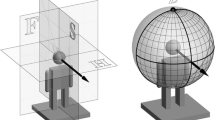Abstract
All the elements of a Fourier analysis can be derived from the experiments of Graham and Robson on contrast sensitivity. Once their experiment is posed as an eigenvalue problem, a complete orthonormal set of eigenfunctions results from solving the associated differential equation. Neither sine and cosine nor Gabor functions result. Instead, the Hermite functions arise as the eigenfunctions of a space-variant differential operator used to model the contrast sensitivity of human observers. These functions, up to a constant, are their own Fourier transforms, and in principle can be used to exactly represent the Fourier transform of naturally occuring visual images.
Similar content being viewed by others
References
Cornsweet TN (1970) Visual perception. Academic Press, New York
Fiorentini A, Mazzantini L (1966) Neural inhibition in the human fovea: a study of interactions between two line stimuli. Atti Fond G Ronchi 21:738–747
Gabor D (1946) Theory of communications. JIEE 93:429–459
Graham NVS (1989) Visual pattern analyzers. Oxford University Press, New York
Graham N, Robson JG, Nachmais J (1978) Grating summation in fovea and periphery. Vision Res 18:815–825
Hermite C (1864) Sur un nouveau developpement en serie des fonctions. Comptes Rendus 58:93–100, 266–273
Jeffreys H, Jeffreys B (1956) Methods of mathematical physics, 3rd edn. Cambridge University Press, London
Kelly DH (1970) Effect of sharp edges on the visibility of sinusoidal gratings. J Opt Soc Am 60:98–103
Koenderink JJ (1988) Operational significance of receptive field assemblies. Biol Cybern 58:163–171
Koenderink JJ, Richards W (1988) Two-dimensional curvature operators. J Opt Soc Am 5A:1136–1141
Koenderink JJ, van Doom AJ (1982) Invariant features of contrast detection: an explanation in terms of self-similar detector arrays. J Opt Soc Am 72:83–87
Koenderink JJ, van Doom AJ (1987) Representation of local geometry in the visual system. Biol Cybern 55:367–375
Marr D (1981) Vision. Freeman, San Francisco
Marr D, Hildreth E (1980) Theory of edge detection. Proc R Soc (London) B207:187–217
Martens J-B (1990) Deblurring digital images by means of polynomial transforms. Comp Vis Graph Image Process 50:157–176
Robson JR (1982) Frequency domain visual processing. In: Braddick OJ, Sleigh AC (eds) Physical and biological processing of images. Springer, New York Berlin Heidelberg
Young RA (1987) The Gaussian derivative model for spatial vision: I. Retinal mechanisms. Spat Vision 2:273–293
Zucker SW, Hummel RA (1986) Receptive fields and the representation of visual information. Hum Neurobiol 5:121–128
Author information
Authors and Affiliations
Rights and permissions
About this article
Cite this article
Stewart, A.L., Pinkham, R. A space-variant differential operator for visual sensitivity. Biol. Cybern. 64, 373–379 (1991). https://doi.org/10.1007/BF00224704
Received:
Accepted:
Issue Date:
DOI: https://doi.org/10.1007/BF00224704




